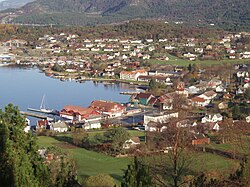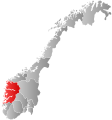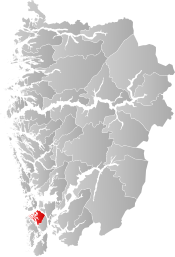Fitjar
Fitjar kommune | |
|---|---|
 View of the village of Fitjar | |
 Coat of arms  Vestland within Norway | |
 Fitjar within Vestland | |
| Coordinates: 59°55′08″N 05°22′17″E / 59.91889°N 5.37139°ECoordinates: 59°55′08″N 05°22′17″E / 59.91889°N 5.37139°E | |
| Country | Norway |
| County | Vestland |
| District | Sunnhordland |
| Established | 1 Jan 1863 |
| Administrative centre | Fitjar |
| Government | |
| • Mayor (2019) | Harald Rydland (KrF) |
| Area | |
| • Total | 142.46 km2 (55.00 sq mi) |
| • Land | 134.47 km2 (51.92 sq mi) |
| • Water | 7.99 km2 (3.08 sq mi) 5.6% |
| Area rank | 317 in Norway |
| Population (2020) | |
| • Total | 3,189 |
| • Rank | 223 in Norway |
| • Density | 23.7/km2 (61/sq mi) |
| • Change (10 years) | 8.8% |
| Demonym(s) | Fitjabu[1] |
| Time zone | UTC+01:00 (CET) |
| • Summer (DST) | UTC+02:00 (CEST) |
| ISO 3166 code | NO-4615 |
| Official language form | Nynorsk[2] |
| Website | fitjar |
Fitjar (Norwegian pronunciation: [ˈfɪ̂tːjɑr] (![]() listen)) is a municipality in Vestland county, Norway. The municipality is located in the traditional district of Sunnhordland. Fitjar municipality includes the northern part of the island of Stord and the hundreds of surrounding islands, mostly to the northwest of the main island. The administrative centre of the municipality is the village of Fitjar.[3]
listen)) is a municipality in Vestland county, Norway. The municipality is located in the traditional district of Sunnhordland. Fitjar municipality includes the northern part of the island of Stord and the hundreds of surrounding islands, mostly to the northwest of the main island. The administrative centre of the municipality is the village of Fitjar.[3]
The 142-square-kilometre (55 sq mi) municipality is the 317th largest by area out of the 356 municipalities in Norway. Fitjar is the 223rd most populous municipality in Norway with a population of 3,189. The municipality's population density is 23.7 inhabitants per square kilometre (61/sq mi) and its population has increased by 8.8% over the previous 10-year period.[4][5]
General information[]


The parish of Fitje was established as a municipality on 1 January 1863 when it was separated from the large Stord Municipality. Initially, the population of Fitje was 2,313. On 1 January 1868, a small area in the municipality of Finnaas (population: 10) was transferred to Fitje. In 1900, the name was changed to Fitjar. The original municipality included all of the land surrounding the Selbjørnsfjorden.
During the 1960s, there were many municipal mergers across Norway due to the work of the Schei Committee. On 1 January 1964, the area of Fitjar located north of the Selbjørnsfjorden on the islands of Huftarøy and Selbjørn (population: 696) was transferred to the neighboring Austevoll Municipality. On 1 January 1995, the islands of Aga, Agasystra, Gisøya, Vikøya, Selsøy, Risøya, and many smaller surrounding islands (population: 225) were transferred from Fitjar to the neighboring Bømlo Municipality. These islands had recently been connected to Bømlo by road bridges which precipitated the municipal transfer.[6]
Name[]
The municipality (originally the parish) is named after the old Fitjar farm, since the first Fitjar Church was built there. The name is the plural form of fit which means "vigorous meadow". Before 1900, the name was written "Fitje".[7]
Coat of arms[]
The coat of arms was granted in the late 1940s. The arms show a golden Viking helmet on a blue background. The helmet and the color are derived from the belief that King Håkon the Good wore a golden helmet at the Battle of Fitjar in 961, which was fought in this municipality.[8]
Churches[]
The Church of Norway has one parish (sokn) within the municipality of Fitjar. It is part of the Sunnhordland prosti (deanery) in the Diocese of Bjørgvin.
| Parish (sokn) | Church name | Location of the church | Year built |
|---|---|---|---|
| Fitjar | Fitjar Church | Fitjar | 1867 |
Government[]
All municipalities in Norway, including Fitjar, are responsible for primary education (through 10th grade), outpatient health services, senior citizen services, unemployment and other social services, zoning, economic development, and municipal roads. The municipality is governed by a municipal council of elected representatives, which in turn elect a mayor.[9] The municipality falls under the Sunnhordland District Court and the Gulating Court of Appeal.
Municipal council[]
The municipal council (Kommunestyre) of Fitjar is made up of 17 representatives that are elected to four year terms. The party breakdown of the council is as follows:
| Party Name (in Nynorsk) | Number of representatives | |
|---|---|---|
| Labour Party (Arbeidarpartiet) | 3 | |
| Progress Party (Framstegspartiet) | 2 | |
| Conservative Party (Høgre) | 3 | |
| Christian Democratic Party (Kristeleg Folkeparti) | 6 | |
| Centre Party (Senterpartiet) | 3 | |
| Total number of members: | 17 | |
Mayors[]
- 1864–1865:
- 1866–1871:
- 1872–1875:
- 1876–1895: (H)[28]
- 1896–1904: (H)[29]
- 1905–1913: (H)[29]
- 1913: (H)[29]
- 1914–1919:
- 1920–1925:
- 1926–1928:
- 1929–1951: (Bp)[30]
- 1952–1955: Harald Henriksen (V)[31]
- 1956–1967: (V)[31]
- 1968–1971: (H)
- 1972–1975: (KrF)
- 1976–1977: (H)
- 1978–1979: (Ap)[32]
- 1980–1981: Ingebrigt Sørfonn (KrF)
- 1982–1983: (H)[33]
- 1984–1985: (Ap)[34]
- 1986–1987: Ingebrigt Sørfonn (KrF)
- 1988–1991: (Ap)
- 1992–1995: (H)
- 1995–1998: (KrF)
- 1998–1999: (Sp)[35]
- 1999–2007: (Ap)
- 2007–2011: (KrF)
- 2011–2019: (H)
- 2019-present: (KrF)
History[]
| Year | Pop. | ±% |
|---|---|---|
| 1951 | 3,092 | — |
| 1960 | 3,172 | +2.6% |
| 1970 | 2,520 | −20.6% |
| 1980 | 2,888 | +14.6% |
| 1990 | 3,072 | +6.4% |
| 2000 | 2,992 | −2.6% |
| 2010 | 2,931 | −2.0% |
| 2019 | 3,201 | +9.2% |
| Source: Statistics Norway. | ||
King Haakon I of Norway (Haakon the Good) maintained his residence at Fitjar. The Battle of Fitjar (Slaget ved Fitjar på Stord) took place in Fitjar on the island of Stord in the year 961 between the forces of King Haakon I and the sons of his half-brother, Eric Bloodaxe. Traditionally, important shipping routes have passed through the area, and the municipality contains several trading posts dating as far back as 1648. Fitjar was separated from Stord in 1863. There have been discussions about a possible reunion of the two municipalities, but no decision has been made.
Geography[]
The island municipality of Fitjar lies south of the Selbjørnsfjorden, west of the Langenuen strait, east of the island of Bømlo. The municipality includes over 350 islands, although most are uninhabited. The majority of the residents live on the island of Stord, the northern portion of which is in Fitjar. The southern portion of the island is part of the municipality of Stord. The island municipality of Austevoll lies to the north, across the fjord and the island municipality of Tysnes lies across the Langenuen strait to the east, and the island municipality of Bømlo lies to the west.[3]
Attractions[]

Fitjar Church was built in 1867 over the site of the old medieval stone church which had been demolished. Stone blocks taken from the old stone church were used as foundations for the present-day church as well as for the walling enclosing the churchyard. Opposite Fitjar Church is Haakon's Park (Håkonarparken), the location of a sculpture of Haakon the Good sculpted by Anne Grimdalen. The statue was erected in 1961 at the one thousand year commemoration of the Battle of Fitjar.[36]
Notable people[]
- Andreas Fleischer (1878–1957) a theologian, missionary to China, Lutheran Bishop and priest in Fitjar Church 1912-1917
- Otto Hageberg (1936–2014) a Norwegian literary historian and academic
References[]
- ^ "Navn på steder og personer: Innbyggjarnamn" (in Norwegian). Språkrådet.
- ^ "Forskrift om målvedtak i kommunar og fylkeskommunar" (in Norwegian). Lovdata.no.
- ^ Jump up to: a b Store norske leksikon. "Fitjar" (in Norwegian). Retrieved 2015-01-28.
- ^ Statistisk sentralbyrå (2020). "Table: 06913: Population 1 January and population changes during the calendar year (M)" (in Norwegian).
- ^ Statistisk sentralbyrå (2020). "09280: Area of land and fresh water (km²) (M)" (in Norwegian).
- ^ Jukvam, Dag (1999). "Historisk oversikt over endringer i kommune- og fylkesinndelingen" (PDF) (in Norwegian). Statistisk sentralbyrå.
- ^ Rygh, Oluf (1910). Norske gaardnavne: Søndre Bergenhus amt (in Norwegian) (11 ed.). Kristiania, Norge: W. C. Fabritius & sønners bogtrikkeri. p. 156.
- ^ "Civic heraldry of Norway - Norske Kommunevåpen". Heraldry of the World. Retrieved 2020-02-02.
- ^ Hansen, Tore, ed. (2016-05-12). "kommunestyre". Store norske leksikon (in Norwegian). Kunnskapsforlaget. Retrieved 2019-04-06.
- ^ "Tall for Norge: Kommunestyrevalg 2019 - Vestland". Valg Direktoratet. Retrieved 2020-02-02.
- ^ Jump up to: a b c d "Table: 04813: Members of the local councils, by party/electoral list at the Municipal Council election (M)" (in Norwegian). Statistics Norway.
- ^ "Tall for Norge: Kommunestyrevalg 2011 - Hordaland". Valg Direktoratet. Retrieved 2020-02-02.
- ^ "Kommunestyrevalget 1995" (PDF) (in Norwegian). Oslo-Kongsvinger: Statistisk sentralbyrå. 1996. Retrieved 2020-02-20.
- ^ "Kommunestyrevalget 1991" (PDF) (in Norwegian). Oslo-Kongsvinger: Statistisk sentralbyrå. 1993. Retrieved 2020-02-20.
- ^ "Kommunestyrevalget 1987" (PDF) (in Norwegian). Oslo-Kongsvinger: Statistisk sentralbyrå. 1988. Retrieved 2020-02-20.
- ^ "Kommunestyrevalget 1983" (PDF) (in Norwegian). Oslo-Kongsvinger: Statistisk sentralbyrå. 1984. Retrieved 2020-02-20.
- ^ "Kommunestyrevalget 1979" (PDF) (in Norwegian). Oslo: Statistisk sentralbyrå. 1979. Retrieved 2020-02-20.
- ^ "Kommunevalgene 1975" (PDF) (in Norwegian). Oslo: Statistisk sentralbyrå. 1977. Retrieved 2020-05-10.
- ^ "Kommunevalgene 1972" (PDF) (in Norwegian). Oslo: Statistisk sentralbyrå. 1973. Retrieved 2020-05-10.
- ^ "Kommunevalgene 1967" (PDF) (in Norwegian). Oslo: Statistisk sentralbyrå. 1967. Retrieved 2020-05-10.
- ^ "Kommunevalgene 1963" (PDF) (in Norwegian). Oslo: Statistisk sentralbyrå. 1964. Retrieved 2020-05-10.
- ^ "Kommunevalgene og Ordførervalgene 1959" (PDF) (in Norwegian). Oslo: Statistisk sentralbyrå. 1960. Retrieved 2020-05-10.
- ^ "Kommunevalgene og Ordførervalgene 1955" (PDF) (in Norwegian). Oslo: Statistisk sentralbyrå. 1957. Retrieved 2020-05-10.
- ^ "Kommunevalgene og Ordførervalgene 1951" (PDF) (in Norwegian). Oslo: Statistisk sentralbyrå. 1952. Retrieved 2020-05-10.
- ^ "Kommunevalgene og Ordførervalgene 1947" (PDF) (in Norwegian). Oslo: Statistisk sentralbyrå. 1948. Retrieved 2020-05-10.
- ^ "Kommunevalgene og Ordførervalgene 1945" (PDF) (in Norwegian). Oslo: Statistisk sentralbyrå. 1947. Retrieved 2020-05-10.
- ^ "Kommunevalgene og Ordførervalgene 1937" (PDF) (in Norwegian). Oslo: Statistisk sentralbyrå. 1938. Retrieved 2020-05-10.
- ^ Utheim, John (1892). Oversigt over Valgmands- og Storthingsvalgene 1891. Kristiania: Steenske bogtrykkeri. p. 35.
- ^ Jump up to: a b c Utheim, John (1901). Oversigt over valgtingene og valgmandstingene 1900. Kristiania: Steenske bogtrykkeri. pp. 57–58.
- ^ Andersen, Thor M. (1931). Norges ordførere 1929–1931. Kristiania: A.M. Hanches Forlag. p. 159.
- ^ Jump up to: a b Norske kommunalpolitikere: Norges styresmenn. 2. Oslo: Bokdepotet forlag. 1956. pp. 323–325.
- ^ Rimmereid, Ingolv (14 November 2000). "Jubilant". Bergens Tidende. p. 24.
- ^ "Ordførar frå Høgre i Fitjar". Bergens Tidende. 16 December 1981. p. 58.
- ^ "T. Ingebrigtsen Fitjar-ordførar". Bergens Tidende. 17 November 1983. p. 10.
- ^ Olderkjær, Ove (2 April 1998). "Bondevik styrer Fitjar". Bergens Tidende. p. 7.
- ^ "Carwalk Fitjar". VisitNorway.com. Archived from the original on 2012-09-17.
External links[]
- Municipal fact sheet from Statistics Norway (in Norwegian)
 Hordaland travel guide from Wikivoyage
Hordaland travel guide from Wikivoyage Media related to Fitjar at Wikimedia Commons
Media related to Fitjar at Wikimedia Commons The dictionary definition of Fitjar at Wiktionary
The dictionary definition of Fitjar at Wiktionary
- Fitjar
- Municipalities of Vestland
- 1863 establishments in Norway



